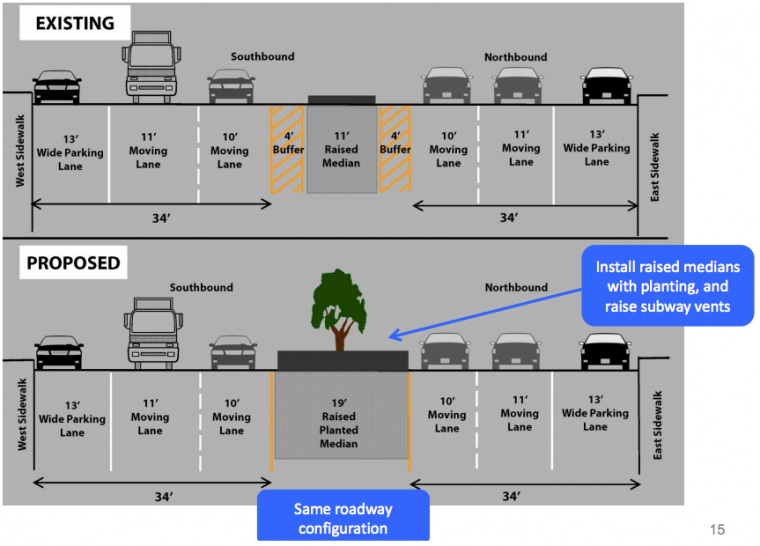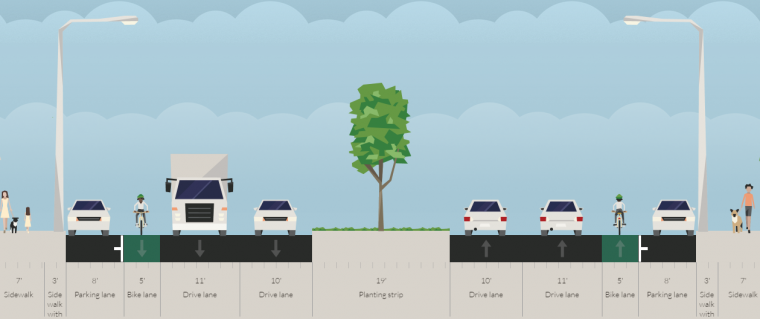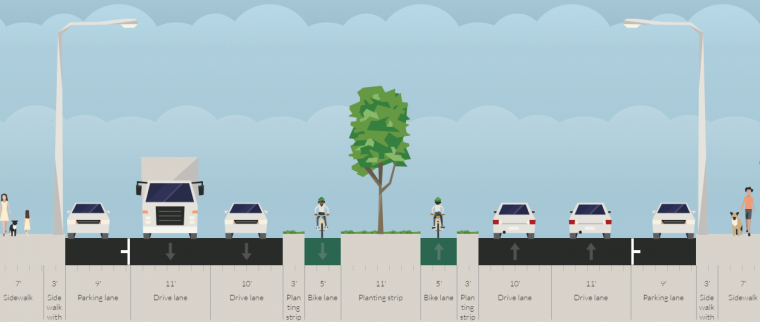Streetsblog reported today that the New York City Department of Transportation will make permanent the road diet on Brooklyn’s Fourth Avenue, which has, until recently, been a regular in Tri-State’s annual Most Dangerous Roads for Walking analyses. The road diet, which used paint and plastic bollards to reduce the number of lanes and widen medians, has led to a 61 percent reduction in pedestrian injuries on Fourth Avenue.
NYC DOT’s proposal includes replacing the existing median/buffer in the center of the right-of-way with a raised median which could host street trees in addition to the existing subway vents. This would be an improvement over the existing arrangement, but it’s hard not to notice a lack of any dedicated bicycle infrastructure.

It’s possible that NYC DOT included wide 13-foot parking lanes to accommodate double parking. Those lanes could instead be divided into eight-foot parking lanes and five-foot bike lanes, but then again, expecting the presence of bike lanes to prevent double parking in New York City would be like expecting the presence of crosswalks to prevent failure to yield. So instead of marking a bike lane, NYC DOT is providing just enough space for parked cars and people on bikes to share, while essentially inviting people to illegally double park.

Perhaps NYC DOT should consider installing bike lanes along the median, perhaps even using that wide center median to include a raised, protected cycle track. Fourth Avenue, with its frequent double parking, would be a good candidate for left-side bike lanes. According to the National Association of City Transportation Officials’ (NACTO) Urban Bikeway Design Guide:
Left-side bike lanes offer advantages along streets with heavy delivery or transit use, frequent parking turnover on the right side, or other potential conflicts that could be associated with right-side bicycle lanes. The reduced frequency of right-side door openings lowers dooring risk.

The overhaul of Fourth Avenue presents a once-in-a-generation opportunity to transform this major thoroughfare. It seems unlikely that Fourth Avenue will truly become a Great Street — or that New York will retain its distinction as America’s Most Bike Friendly City — if NYC DOT moves forward with a proposal to squeeze people on bikes between moving traffic and parked cars.

Have you ever seen how poorly Allen/Pike Street handle the possibility of passing today? There is a reason cycletracks in The Netherlands are supposed to be 2 meters (~6’5″) wide at minimum.
[…] Tri-State Has a Design Suggestion for Fourth Avenue in Brooklyn (MTR) […]
Thank you for posting this!!! The DOT’s 4th Ave proposal is a huge missed opportunity that would take decades to undo.
This is better but I would increase the size of the bicycle lanes a bit, perhaps by a foot and a half on each side at the expense of some of the planting median.
NYC-DOT is supposed to leverage existing transportation investments to increase the productivity of the streets. Yet just when NYC-DOT has approved the expansion of Citibike to Park Slope and 4th Avenue, it is making cycling there more dangerous? http://citibikeblog.tumblr.com/post/101182979267/expansion-woo-hoo
At the 2010 outset of proposed roadway changes to 4th Avenue(BP’s Hunter College study–remember?) bike lanes were dismissed because there was just too much traffic on 4th Avenue and that level would still be true after the changes. The subsequent ‘calming’ only compressed that traffic thus making bike-riding that much more risky to all. At no time did NYCDOT challenge that initial stipulation. As was suggested back then 5th Avenue got a bike lane.
Of course, today bikers regularly ride on the yellow-striped area between the center-median and the fast lane in each direction. This makes me question the need for any buffers–cyclist seem comfortable riding nearer speeding cars and trucks in the ‘express bike lanes’. Why advocates insist on ever-wider buffers confounds me. These cyclists exhibit no stress that I can see.
This alternative proposal is just silly, if not really dangerous. 4th Avenue is a heavily-traveled urban arterial roadway, part of the Federal Highway System(see MAP-21). Further obstruction of the existing roadway will mean continual gridlock during daylight hours when traffic must come to a halt when a car stops to discharge a passenger at any of the many schools, subway stations, retail outlets, etc. The soon-to-be concrete median barriers will eliminate the ‘express lanes’ and deny any maneuverability to cars on the roadway. Watch out!
[…] Meanwhile in Brooklyn, instead of a coherent network of bike lanes, DOT proposed three different designs for bike lanes along Brooklyn and Kingston Avenues for three different community boards. And last year, a proposal for Fourth Avenue–one of the borough’s most deadly roads–didn’t include any bike lanes at all. […]